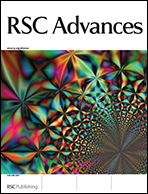Efficient removal of Cd2+ by dialdehyde phenylhydrazine starch from aqueous solution
Abstract
Three similar adsorbents were prepared via the conjugation of o-phenylenediamine (PDA), m-phenylenediamine (MPA) and phenylhydrazine (PH) with dialdehyde starch (DAS) and designated as DASPDA, DASMPA, DASPH, respectively. The adsorption properties of the three adsorbents toward metal ions were determined, and the results indicated that DASPH had a good adsorbability to Cd2+ among different metal ions. The DASPH was characterized by elemental analysis, BET, FT-IR spectra and SEM. FT-IR of DASPH revealed the incorporation of the C![[double bond, length as m-dash]](https://www.rsc.org/images/entities/char_e001.gif) N group (1601.1 cm−1) and the disappearance of the C
N group (1601.1 cm−1) and the disappearance of the C![[double bond, length as m-dash]](https://www.rsc.org/images/entities/char_e001.gif) O (carbonyl) group (1733.4 cm−1). DASPHs with different degrees of substitution (0.48, 0.72 and 0.86) of phenylhydrazine were prepared and their adsorption properties for Cd2+ from aqueous solution were investigated. Adsorption of Cd2+ towards DASPH was optimized by pH, contact time, initial Cd2+ concentration and temperature. The adsorption capacity increased with the increasing DS (degree of substitution) of the DASPH, and reached 4.021, 4.034 and 4.163 mmol g−1, respectively, for DASPH1, DASPH2 and DASPH3. The adsorption equilibrium data were correlated well with the Freundlich isotherm model. The present adsorption system can be described more favorably by the pseudo-second-order kinetic model. Moreover, lower temperature was preferable for the process as it was exothermic.
O (carbonyl) group (1733.4 cm−1). DASPHs with different degrees of substitution (0.48, 0.72 and 0.86) of phenylhydrazine were prepared and their adsorption properties for Cd2+ from aqueous solution were investigated. Adsorption of Cd2+ towards DASPH was optimized by pH, contact time, initial Cd2+ concentration and temperature. The adsorption capacity increased with the increasing DS (degree of substitution) of the DASPH, and reached 4.021, 4.034 and 4.163 mmol g−1, respectively, for DASPH1, DASPH2 and DASPH3. The adsorption equilibrium data were correlated well with the Freundlich isotherm model. The present adsorption system can be described more favorably by the pseudo-second-order kinetic model. Moreover, lower temperature was preferable for the process as it was exothermic.


 Please wait while we load your content...
Please wait while we load your content...